Introduction to
Health and Wellness
Learning Targets
As a result of today’s class, you should know:
- The 6 Dimensions of Wellness and how they are interrelated
- How to explain how the decisions you make affect where you fall on th e Health Continuum
Wellness: The New Health Goal
- Health is the combination of physical, mental/emotional, and social well-being.
- Is subject to constant change (i.e. you get sick, an athletic injury, etc.)
- Falls along a continuum (from premature death to high levels of health)
- Wellness refers to an overall state of well- being, total health
- Health differs based on factors beyond your control, such as genes, age, environm ent, media, and family history
- Wellness is determined by the decisions you make about the way you live
- These two words can be used interchangeably and will be throughout this course
- Wellness = an overall state of well-being, total health
- Dimensions of wellness
- Physical wellness
- Avoiding bad habits, making good decisions
- Emotional wellness
- Trust, self-esteem, self-control
- Intellectual wellness
- Openness to new ideas, thinking critically, creativity
- Spiritual wellness
- Set guiding beliefs, principles
- Interpersonal and social wellness
- Healthy relationships, communication
- Environmental, or planetary, wellness
- Tobacco smoke, UV rays
Wellness Continuum
Health/Wellness Continuum
- Your health is always changing
- The Health continuum identifies your level of health at a given moment in time
- The dimensions of wellness all impact your overall health
- The dimensions are not exclusive; when one is affected, most often, others are too.
- Every decision you make affects where you fall on the health continuum
- Man vs. Wild Clip
- Think about the dimensions of wellness present in this clip. Which dimensions are present and how do they affect Bear Grylls in this clip? Consider the context of the situation and the interrelatedness of the dimensions of wellness.
New Opportunities, �New Responsibilities
- Infectious diseases, caused by invading microorganisms, were the leading causes of death a century ago
- Chronic diseases, caused by a variety of lifestyle and other factors, are the leading causes of death today
Public Health Achievements
Leading Causes of Death Overall
- Heart disease
- Chronic lower respiratory diseases (emphysema, chronic bronchitis)
- Unintentional injuries (accidents)
Leading Causes of Death by Age
- Ages 1 0-19
- 1) Accidents
- 3) Homicide
- 5) Congenital Defects
- 1) Heart Disease
- 3) Diseases
- Define health.
- What are 3 factors that impact your health?
- What is the most important factor that impacts your health?
- What are the 6 dimensions of wellness?
- E xplain the Health Continuum.
- Is the average lifespan of a human increasing or decreasing? Why?
- As a result of this class, students should be able to:
- Identify the 8 behaviors that contribute to wellness
- Define risk behavior and be able to identify examples
- Set short and long-term goals that aim at improving health
- Identify reliable sources of information
Actual Causes of Death in the United States
- Smoking 435,000 deaths per year
- Diet and inactivity** 112,000
- Alcohol 85,000
- Microbial agents 75,000
- Toxic agents 55,000
- Motor vehicles 43,000
- Firearms 29,000
- Sexual behavior 20,000
- Illicit drug use 17,000
**Caclulation of the number of deaths due to poor diet and inactivity (obesity) is an area of ongoing controversy and research.
Sources: Centers for Disease Control and Prevention. 2005. Frequently Asked Questions About Calculating Obesity-Related Risk (http://www.cdc.gov/od/oc/media/pressrel/r050614.htm; retrieved June 28, 2005). Mokdad, A. H., et al. 2004. Actual causes of death in the United States, 2000. Journal of the American Medical Association 291(10): 1238–1245.
Behaviors That Contribute to Wellness
Partaking in these 8 behaviors will make you a healthier person:
- Be physically active
- Choose a healthy diet
- Maintain a healthy body weight
- Manage stress effectively
- Avoid tobacco and drug use and limit alcohol consumption
- Protect yourself from disease and injury
- Get 8-10 hours of sleep a night
- Abstain from sexual activity before marriage
Lifestyle and Wellness
- More time watching TV = increased risk of obesity and diabetes
- Cigarette smoking = increased risk of lung cancer
- Low intake of fruits and vegetables = increased risk of heart disease
- Few healthy behaviors = increased risk of heart disease
Benefits of Physical Activity
The Role of Other Factors in Wellness
- Heredity – inherent genetic traits
- Risk for certain diseases
- Environment – the sum of your surroundings
- Physical, Social (Peers), Cultural
- Health care
- Better health care, better treatment
- Avoid bad habits
National Wellness Goals
- U.S. government’s national Healthy People initiative sets goals on 10-year agendas
- Major goals of Healthy People 20 2 0 :
- Attain high-quality, longer lives free of preventable disease, disability, injury, and premature death.
- Achieve health equity, eliminate disparities, and improve the health of all groups.
- Create social and physical environments that promote good health for all.
- Promote quality of life, healthy development, and healthy behaviors across all life stages.
Making Choices
- Risk behaviors – actions that can potentially threaten your health or the health of others
The CDC Youth Risk Behavior Survey gathers information from youth across the country on behaviors they are involved in. Take a look at the most recent YRBS in 2011.
- What are the 8 behaviors of healthy people.
- Discuss how technology plays a role in your health.
- What is a risk behavior? Give 2 examples.
- Define the acronym SMART
- Explain the key components of assertive communication skills.
- As a result of today’s class, you should be able to:
- Create short and long term goals to make changes to your health
- Evaluate the validity of electronic sources
7 Health Skills
- Accessing information
- Analyzing influences
- Goal setting
- Decision making
- Interpersonal communication
- Self management
Accessing Information
- Reliable sources include :
- Parents, teachers, trusted adults
- Library resources such as encyclopedias and nonfiction books
- RELIABLE websites such as government sites or university sites (.gov, .edu)
- .com websites are NOT considered reliable sources
- Articles by health experts
Evaluating Sources of Health Information: Internet Resources
- What is the source of the information?
- Who is the author or sponsor of the site?
- How often is the site updated?
- What is the purpose of the page? Does the site promote particular products or procedures? Are there obvious reasons for bias?
- What do other sources say about the topic?
- Does the site conform to any set of guidelines or criteria for quality and accuracy?
Evaluating Sources of �Health Information
- Go to the original source
- Watch for misleading language
- Distinguish between individual research reports and public health advice
- Remember that anecdotes are not facts
- Be skeptical and use your common sense
Analyzing Influences
- Internal pressures
- Feelings, beliefs
- External pressures
- People, environment
Goal Setting
- Start with short-term goals which are reached in a short period of time and are very specific
- Create short-term goals with a long-term goal in mind – one that is a big change over a long period of time. Long-term goals are the final, desired outcome
- Short-term goals are steps leading to the long-term goal
See Assignment ‘Source Evaluation’
- http://www.bodybuilding.com/store/creatine.html
- http://www.umm.edu/altmed/articles/creatine-000297.htm
1. Describe 3 aspects of effective listening skills.
2. What are 3 ways you can demonstrate refusal skills in a situation that you are not comfortable with?
3. What are ‘I-messages?’
4. Describe 3 aspects of healthy relationships.
You are interviewing for a part-time job working with patients at the local hospital.
- How will you dress?
- What type of legwork will you do before the interview?
- What skills and behaviors would be necessary to be successful at the job?
- How will you continue to improve at your job once you have earned the position?
- You have been asked to do research on the internet to find reliable information about tobacco use among teens. Websites with which endings would be considered reliable sources?
- You are dealing with a classmate who is clearly disagrees with your choice for next president of the US. What are 2 things you could say to your classmate using assertive communication skills?
- You have come across a website on nutrition and are wondering if the information on the site is reliable. What are 3 questions you can ask to help determine the sites reliability?
- There is a flu epidemic at Saline High School. What are 3 things you can do to prevent the further spread of disease?
- How much sleep is required for teens to function best throughout the day?
- What are 3 things you can do to help better manage your time?
- What are 3 different things that impact your health on a daily basis?
An official website of the United States government
The .gov means it’s official. Federal government websites often end in .gov or .mil. Before sharing sensitive information, make sure you’re on a federal government site.
The site is secure. The https:// ensures that you are connecting to the official website and that any information you provide is encrypted and transmitted securely.
- Publications
- Account settings
Preview improvements coming to the PMC website in October 2024. Learn More or Try it out now .
- Advanced Search
- Journal List
- Open Access Maced J Med Sci
- v.6(1); 2018 Jan 25


Health and Illness in History, Science and Society
Miriam rovesti.
1 Department of Dermatology, University of Parma, Parma, Italy
Massimo Fioranelli
2 G. Marconi University - Department of Nuclear Physics, Subnuclear and Radiation, Rome, Italy
Paola Petrelli
Francesca satolli.
3 Dermatology, Via Gramsci 14, Parma 43126, Italy
Maria Grazia Roccia
4 University B.I.S. Group of Institutions, Punjab Technical University, Punjab, India
Serena Gianfaldoni
5 Dermatology and Venereology, University G. Marconi of Rome, Rome 00192, Italy
Georgi Tchernev
6 Medical Institute of Ministry of Interior Department of General, Vascular and Abdominal Surgery, Sofia, Bulgaria
Uwe Wollina
7 Städtisches Klinikum Dresden, Department of Dermatology and Allergology, 01067 Dresden, Germany
Jacopo Lotti
Claudio feliciani, torello lotti.
8 University G. Marconi of Rome, Dermatology and Venereology, Rome, Italy
Health is a fundamental human right. The World Health Organization defines it as a “state of complete physical, psychological and social well - being and not merely the absence of disease or infirmity”. The health of individuals, however, is also linked to the environment in which they live and especially to their ability to adapt and integrate into their life context. The relationship with the environment is extremely important because it is that interaction that outlines the concept of normality compared to pathology. Such normality needs to be contextualised by gender, geographical origin and by the individuals’ living conditions: as a matter of fact, what is normal for a young person may differ from what is normal for a senior one. That is to say, the concept of health is indeed relative and it is the result of an interesting evolution of the concept of illness. From the first approaches - dealing with the mere treatment of the symptoms - to the promise of a free-from-pain society, science and economics have played a significant role in redefining the dualism health/ illness. The article reflects on these two concepts, health and illness, in history and nowadays, and discusses the future of the medical science.
Introduction
Analysing the concept of illness is a rather complex task. Just like for the concept of health – presented by the philosopher Hans - Georg Gadamer as a “[…] general feeling of personal well-being [which] appears mostly when we, in our feeling of personal well-being, are open to new things, are ready to start new business, without considering demands made on us” [ 1 ] - there is an important dimension of relativity that needs to be considered: it could be stated that, in the presence of illness, there is a significant change in the functionality of an organ or the entire organism. W. E. Boyd maintains that “illness is a change of the condition in which the organism is in perfect harmony with its environment […]” [ 2 ].
The concept of illness has evolved. In the past, it was linked to the presence of microbes. Later, the emphasis was placed on the constitution and the environment. Nowadays, illness is seen as a system that the body puts in place to find again its lost balance [ 3 ] In ancient times, feeling ill concerned the individual only; today, a state of illness can be diagnosed by a physician by objective criteria. Therefore the concept of illness can be seen from many different perspectives.
It is interesting to note that, in the English language, there are three terms to indicate a pathological state: illness, which identifies the personal emotional state connected to the loss of health; disease, which refers to the objective, biological and measurable dimension of it - strictly linked to the physician’s activity - and sickness, which refers instead to the public dimension of the disease and highlights the link between illness and society.
Compared to the ontological model, which aims at eliminating the symptoms, the functional/relational model considers the illness as a dynamic event, an endogenous reaction to the break of a balance. In this perspective, body and mind are inseparable: it is the entire organism that becomes ill, not the single organ. In this model, the physician/patient relationship is crucial, and the physician promotes self - healing processes [ 4 ]. Western medicine fully adheres to the so-called scientific method, intended as a set of rules that governs the process of acquiring knowledge. Key elements of the scientific method are the experimental observation of a natural event, the formulation of a general hypothesis in which this event occurs, and the ability to control the hypothesis through subsequent observations.
Science, after a long period in which it was interpreted as true in an absolute sense, completely changed after Albert Einstein, who, with his theory of relativity, laid the basis of quantum physics. Almost simultaneously, the aetiological agents of infectious diseases were discovered, and the first effective remedies to control them were introduced. At first, the arsenical compounds discovered by Paul Ehrlich – which were capable of inhibiting bacterial growth - and then the first antibiotics. Medicine thus became somewhat omnipotent, promising a free-from-pain society. The discoveries of the new physics did not affect the certainties of the twentieth-century medicine. This lack of integration has led the scientific - medical thinking to the reality we experience today.
The relationship between health, nutrition and environment
We cannot speak of health and illness without considering the issue of the environment. As stated by Paul Crutzen – who was awarded the Nobel Prize in Chemistry in 1995 – we might call the geological age in which we live as Anthropocene, that is the era ruled by men. For thousands of years, human beings used for their nutrition and needs plants, seeds and animals: a whole biological world, the result of millions of years of evolution. The richness and variety of our food is the result of extraordinary natural biodiversity. With the arrival of the Modern Era, a gradual extinction of animal and plant species has begun. Alterations and destructions have become exponential: over the last fifty years, we lost more biological heritage than in any previous era. Furthermore, the disappearance of a plant or an animal involves the impossibility of survival of other species connected to them.
In the nineties, some multinational corporations put on the market a variety of genetically modified (GM) corn, soybean and cotton seeds never seen before in the entire history of farming. To date, no epidemiological investigation has ever been conducted to reassure the general public on the effects of GMOs on human and animal health.
GMOs do not exist in nature: they are the result of a manipulation that - to a certain extent – removes the natural barriers between species. An example of how genetic manipulation might influence the health of entire populations is the one concerning the manipulation of cereals [ 5 ].
In the last few years, the use of hyper-fertilised wheat has led to an artificial increase of its gluten content: plus 12% compared to a standard one. Gluten is a lipoprotein found in wheat flour which mainly derives from the combination, through water, of two molecules: glutenin and gliadin. This increased concentration of gluten proteins, often three times more than the one our ancestors’ organisms were used to, makes the wheat very different from the “old” and best-tolerated ones. The selection of such wheats is surely the cause of many gluten-related health problems. Our organism has not evolved enough to digest a large amount of these substances. Gluten sensitivity and the coeliac disease are only two of several pathologies related to this issue.
The influence of economics on the treatment of illness
Economic sustainability is now an issue to which health policies for prevention and treatment are inextricably linked. In recent decades, the healthcare expenditure in Western countries has shown a steady increase and health today is the most important sector of the economy of a nation. Western countries annually spend on healthcare a significant part of their gross domestic product (GDP). The United States in 2003 spent $ 5,635 - the 14% of GDP - for every single citizen: only $ 1,500 out of this amount were spent for the annual consumption of drugs per capita. Our country in 2005 spent €125 billion that is 7.8% of GPD [ 6 ].
The causes of this huge expenditure for acute and chronic diseases are multiple and complex. According to Voltaire, the physician’s art would be to entertain the patient until nature heals him. Today, instead, we are witnessing the opposite phenomenon: many conditions, once considered as physiological, can now be considered as subject to therapeutic intervention.
Normal phenomena such as shyness, baldness, apathy, ageing, fatigue and unhappiness are considered as conditions that can be cured: new diseases that must be treated, often in a costly way [ 7 ].
Current challenges and future directions in medical science and health care policies and practice
The framework of the current situation is the increase in the number of diagnoses that, in industrialised countries, has reached grotesque dimensions. It is believed that Homo Sapiens had about 40,000 among diseases, syndromes and disorders. Fortunately, there is a remedy for most diseases. Nowadays the pharmaceutical industry keeps investing in research; however, it spends more for marketing than for innovation. About a third of the revenues and a third of the staff are used only to sell medicines [ 8 ].
The issues discussed so far call for a profound reflection about the future of the medical science: a modern health care system will be sustainable only if prevention policies are developed, through the protection of the environment and the promotion of correct eating habits.
It is fundamental, after all, to highlight that - to proceed in this regard - it is necessary to consider the role that culture has always played in the perception that every single person has about taking care of himself/herself. The link between health and care is an interesting topic that is being currently considered by social studies: in particular, the influence that culture and society have on people and their way of keeping healthy is being investigated. Research that starts from the assumption that “culture, as a complex system, is a way of organizing individuals and the relationships that connect them” [ 9 ].
Funding: This research did not receive any financial support
Competing Interests: The authors have declared that no competing interests exist
Health Presentation Templates
Venngage's health presentation templates offer a dynamic platform for professionals to convey vital medical information effectively and engagingly.
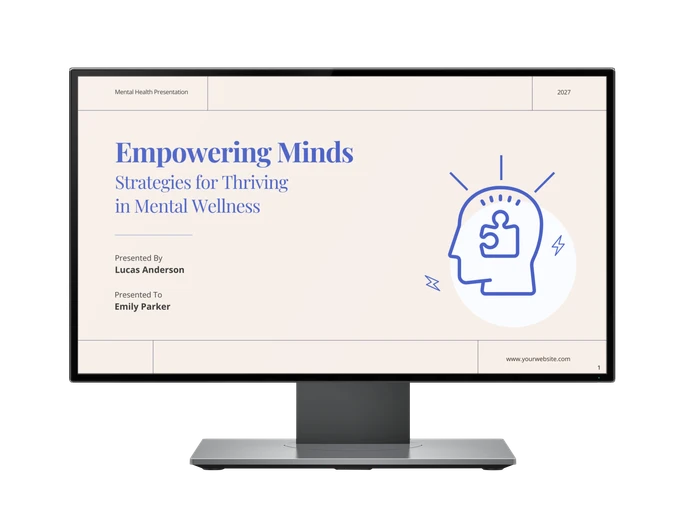
Other presentation templates
- Pitch decks
- User persona
- Brand guidelines
- Professional
- Group project
- Valentine's day
- Book report
- Mother's day
- Father's day
- Visual chart
- Architecture
- Social media
- Advertising
Popular template categories
- Infographics
- White papers
- Letterheads
- Newsletters
- Business cards
- Human resources
- Certificates
- Invitations
- Table of contents
- Magazine covers
- Price lists
- Album covers
- Book covers
- See All Templates
Academia.edu no longer supports Internet Explorer.
To browse Academia.edu and the wider internet faster and more securely, please take a few seconds to upgrade your browser .
Enter the email address you signed up with and we'll email you a reset link.
- We're Hiring!
- Help Center

Powerpoint Presentation for HEALTH WELLNESS AND ILLNESS

WHO defines health as “a state of complete physical, mental and social well being and not merely the absence of disease or infirmity” Message me for full pptx presentation [email protected] Upload seemed convert to pdf form
Related Papers
Stephanie Hill
British Medical Journal
Military Medicine
Kent Bradley
PsycEXTRA Dataset
Robert Pangrazi
Upublish.info
Flourish Itulua-Abumere
Everyone involved in health and social care occupation starts with the knowledge and understanding of health. The views and perception of health is different from person to person and culture to culture. This article aims to define and explain health, expose the concept of health and bring to light dimensions of health as well as its social construct. The word health is derived from whole, hale and healing, signaling that health concerns the whole person and his or her integrity, soundness or well being. (Naidoo and Wills, 1994)
Medical Sociology in Africa
Jimoh Amzat
Culture, Medicine and Psychiatry
Sjaak van der Geest
Waltraude Woods
Saira Afzal
Loading Preview
Sorry, preview is currently unavailable. You can download the paper by clicking the button above.
RELATED PAPERS
Autonome Mobile Systeme
Reumatología Clínica
Mickael Essouma
The Astrophysical Journal
Biswajit Paul
The Journal of Object Technology
Burkhart Wolff
Alireza Najafpour
Marco Spalletti
Business and Management Research
Gunnar Svendsen
Abera Kenay Tura
Literature and Medicine
Berit Åström
Critical Sociology
Ivanka Knezevic
International Journal of Current Microbiology and Applied Sciences
VISHNU PREYA S -MBA2022
ABM Proceedings
Beatryz Mendes
Angel Morales Molina
BMC Public Health
Ramon Ottenheijm
Nucleic acids research
Liselott Stadler
Journal of Ege University School of Dentistry
Furkan Cıcık
Atisha Sachan
Teaching and Supervision in Counseling
Kathy Evans
Yulvian Sani
Ahmad Febriansyah
Tạp chí Y học Việt Nam
Nguyễn Thị thanh hằng
Energy Policy
Bilal Akash
Journal of Clinical Investigation
David Feldman
Critical Care
sara-joan pinto
RELATED TOPICS
- We're Hiring!
- Help Center
- Find new research papers in:
- Health Sciences
- Earth Sciences
- Cognitive Science
- Mathematics
- Computer Science
- Academia ©2024

- My presentations
Auth with social network:
Download presentation
We think you have liked this presentation. If you wish to download it, please recommend it to your friends in any social system. Share buttons are a little bit lower. Thank you!
Presentation is loading. Please wait.
HEALTH & ILLNESS.
Published by Amelia Hunt Modified over 9 years ago
Similar presentations
Presentation on theme: "HEALTH & ILLNESS."— Presentation transcript:
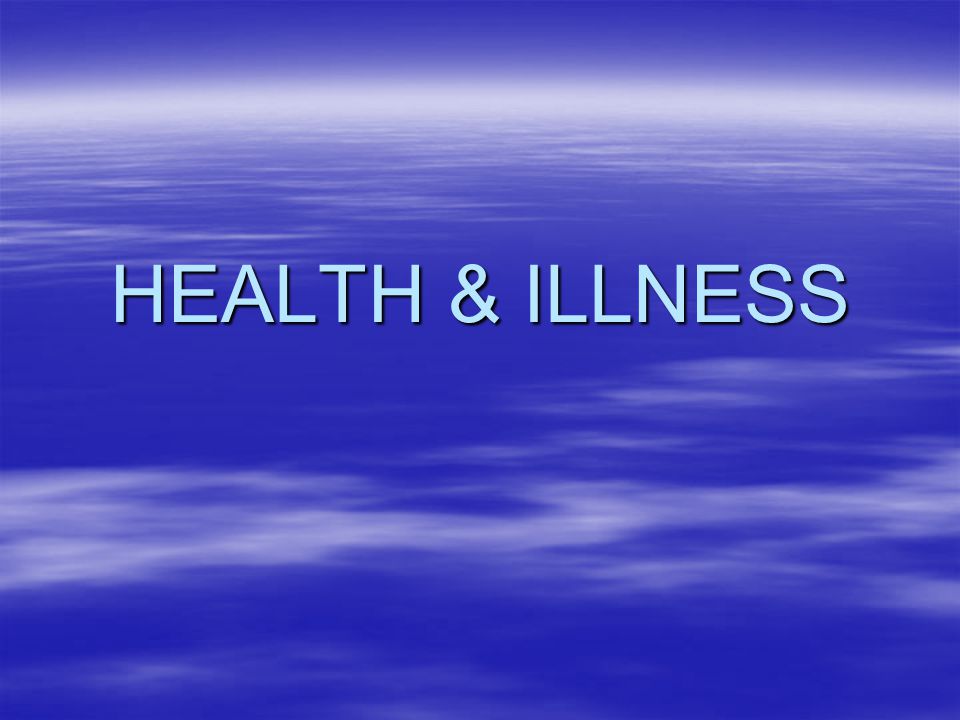
Nursing Management of Clients with Stressors that Affect Health Promotion NUR101 Fall 2008 Lecture # 25 K. Burger, MSEd, MSN, RN, CNE PPP By: Sharon Niggemeier.

Traditional Health beliefs and practice Dr. Dina Qahwaji.

Concepts of Health, Wellness, & Well-Being

Chapter 4 Health and Illness

Health Promotion and Disease Prevention Roxanne Riedy, MSN Marilee Elias, MSN.

Wellness Theories What does it mean to be healthy?

Population Health for Health Professionals. Module 3 Health Promotion and Individual Behavior Change.

Health Maintenance, Health Promotion, and Wellness

Copyright © 2005 Mosby, Inc. All rights reserved. Slide 0.

Health and Illness Chapter 4. Definitions Health: defined by each person WHO: “Health is a state of complete physical, mental, and social well being,

HE 250 WESTERN OREGON UNIVERSITY Welcome to Personal Health.

Perspective in pediatric nursing

Health and Wellness: Introduction to Health Promotion/Disease Prevention Copyright © 2003, Mosby, Inc. All rights reserved.

HEALTH, WELLNESS AND ILLNESS. W HAT I S H EALTH ?

LEADING A HEALTHY LIFESTYLE

Copyright © 2013 Wolters Kluwer Health | Lippincott Williams & Wilkins Chapter 2 Health Promotion and Disease Prevention.

Health Health Determinants and Health Promotion Diane B. Wilson EdD, RD Mary S. McLellan MS,RD Medical University of South Carolina.

Focussed Assessment of a Cultural Group n The following slides outline areas you can research about the cultural group you have selected. Do you best to.

HEALTH, WELLNESS, ILLNESS & DISABILITY
About project
© 2024 SlidePlayer.com Inc. All rights reserved.

Sickness And Health PPT
Download this sickness and health PPT and use it in class today. This PowerPoint lesson is for teaching English lessons about sickness and health. The presentation includes slides to practice sickness vocabulary in English and slides to practice asking and answering ‘ What’s the matter? ‘ – ‘ I’ve got a (fever) .’ Key vocabulary includes headache, toothache, cold, fever, cough, stomachache, sore throat and rash. See below to preview and download this PPT and check the bottom of the page for related resources.
Related Resources
For more lesson materials for teaching about sickness and health in English, check out these related resources: Health And Sickness Flashcards Sickness And Health Vocabulary Exercises

- Search Search Search …
Health And Wellness
Free templates for health and wellness for powerpoint and google slides.
Make your presentations and lessons stand out with these free templates for Health and Wellness .
Download them to use with PowerPoint or edit them in Google Slides and start creating!

Elevate Your Presentations with Earthy Elegance and Sophistication with this free PowerPoint Template and Google Slides Theme. Beth is a stunning free template for Google Slides and PowerPoint, featuring a soothing palette of earthy tones, organic shapes, and leaves. The template is designed to exude a sense of natural elegance […]
Beth, elegant and versatile free template.

Green Minimal Boho free PowerPoint Template and Google Slides Theme This free PowerPoint template and Google Slides theme features a boho and minimal style with geometric and organic shapes along with a few leaves. As usual, even though I chose sage green and beige, you can edit the theme and […]
Green Minimal Boho free slides template.

Neutral watercolors organic shapes free PowerPoint Template and Google Slides Theme This template features neutral watercolor organic shapes and it can be used for presentations about topics such as: Nature: For example, you could use the template to discuss the different types of trees, flowers, or animals in a particular […]
Watercolor Organic Shapes Presentation Template.

Beautiful and elegant free PowerPoint Template and Google Slides Theme Looking for a beautiful and elegant way to present your work? Look no further than this pastel floral Google Slides theme and PowerPoint template! With its soft colors and hand drawn flowers, this template is perfect for any occasion, from […]
Helena, poetry reading or classic book review free template.

Free purple flowers photo background template for Google Slides and PowerPoint. This Google Slides template features beautiful images of a flat lay of purple wildflowers. The template includes a variety of slides with different layouts, so you can easily create a presentation that is both informative and visually appealing. You […]
Purple wildflowers photo background free template.
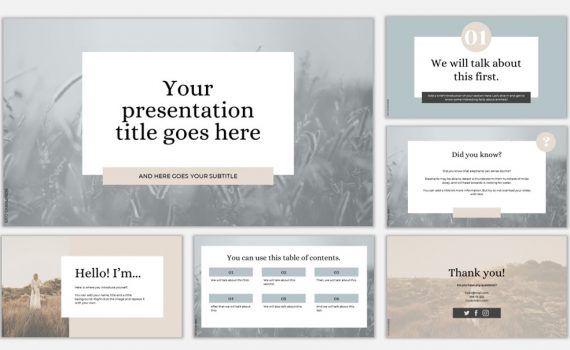
Free Google Slides and PowerPoint template for fashion or interior design. This template is ideal for fashion-related or interior design presentations, it features pictures of golden crop fields as background that you can replace with your own. The template has a simple and formal design, with clean layouts, minimal colors, […]
Golden Fields, a free template for fashion or interior design.

Gold and brown leaves. Free template for Google Slides and PowerPoint. Cassidy is a beautiful template with different brown shades and touches of gold. Perfect for a presentation about literature or art. Or to celebrate Fall. I’ve used theme colors, so if you wish to change its colors, follow this […]
Cassidy, brown and gold leaves. Beautiful illustrated slides.

Free PowerPoint template and Google Slides theme. Template with a shadow overlay. Agnes is a beautiful inspirational slides theme. The shadow overlay gives it a unique touch and it can be easily adapted to different topics by simply changing the images of the plants, for pictures that represent your presentation […]

Agnes, elegant botanical theme.

Free PowerPoint template and Google Slides theme. Summer reading slides. Book analysis template. It features a beach scene seen from above and an open book seen from the reader’s perspective. I’ve included one slide with hidden text, that can only be read by moving (wearing) the sun glasses, simply drag […]
Summer reading, summer book club template.

Free Spring Template for PowerPoint or Google Slides, Vivian. Vivian is a free Google Slides theme or pptx template inspired by spring. Little bouquets of wildflowers make this theme perfect to celebrate spring. By editing the master, you can change the colors of each type of flower. Vivian asked me for […]
Vivian Free Spring Template for Google Slides or PowerPoint presentations

Free Template for PowerPoint or Google Slides Presentations Rochester Rochester is a free and elegant template for Google Slides or PowerPoint. It works for a presentation, school lesson or assignment about classic literature. It’s also perfect for planning a wedding or if you are a wedding planner, you can use Rochester […]
Rochester Free Elegant Template for Google Slides or pptx
Got any suggestions?
We want to hear from you! Send us a message and help improve Slidesgo
Top searches
Trending searches

infertility
30 templates

linguistics
89 templates

15 templates

28 templates

public health
35 templates

holy spirit
38 templates
Health Subject for Elementary - 3rd Grade: Wellness & Disease Prevention
Health subject for elementary - 3rd grade: wellness & disease prevention presentation, free google slides theme and powerpoint template.
Teaching kids what to do to prevent illnesses has always been an important thing, but due to the COVID-19 pandemic, now it's even more crucial than ever. To make your lesson more interesting for your students, you can try using this editable template and create a slideshow with it. Since it contains cartoony sticker illustrations and big titles, you'll find it easier to convey the contents!
Features of this template
- 100% editable and easy to modify
- 37 different slides to impress your audience
- Contains easy-to-edit graphics such as graphs, maps, tables, timelines and mockups
- Includes 500+ icons and Flaticon’s extension for customizing your slides
- Designed to be used in Google Slides and Microsoft PowerPoint
- 16:9 widescreen format suitable for all types of screens
- Includes information about fonts, colors, and credits of the free resources used
How can I use the template?
Am I free to use the templates?
How to attribute?
Attribution required If you are a free user, you must attribute Slidesgo by keeping the slide where the credits appear. How to attribute?
Related posts on our blog.

How to Add, Duplicate, Move, Delete or Hide Slides in Google Slides

How to Change Layouts in PowerPoint

How to Change the Slide Size in Google Slides
Related presentations.

Premium template
Unlock this template and gain unlimited access

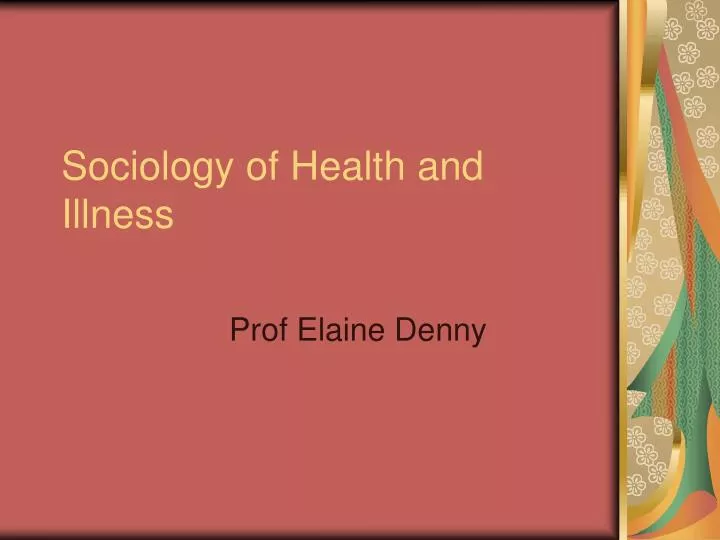
Sociology of Health and Illness
Nov 20, 2014
480 likes | 1.52k Views
Sociology of Health and Illness. Prof Elaine Denny. Key questions you might ask. What accounts for socio-economic inequalities in health? How do social structures, institutions and processes affect the health of individuals? What is the nature of the doctor-patient relationship
Share Presentation
- health care
- social structures
- sociology examines
- receiving health care
- lay people make sense

Presentation Transcript
Sociology of Health and Illness Prof Elaine Denny
Key questions you might ask • What accounts for socio-economic inequalities in health? • How do social structures, institutions and processes affect the health of individuals? • What is the nature of the doctor-patient relationship • How do lay people make sense of health and illness? • What impact do health care services have on individuals and society?
You can apply these questions to the topics you will be asked to study
Sociological perspectives • Two broad approaches to study: • MACRO approaches • MICRO approaches
Macro approaches • Emphasise how health and illness is influenced by social structures and institutions outside of the control of individuals • E.g. the government • Education • Income support • housing
Macro approaches • Marxist or political economy perspectives • Structuralist • Functionalist • Feminists
Micro approaches • Emphasis is on how individuals and groups interact, and how this gives rise to shared ideas about health and illness • This occurs through socialisation (shared norms and values)
Micro approaches • Interactionalists • Interpretivists
Contribution of sociology • In contrast to approaches such as physiology or psychology sociology examines the social dimensions of health, illness and health care • Social patterning of health and illness • Inequalities in health – ethnicity, gender, social class
Aboriginality, lifestyle and genetics – obscuring social processes (White 2002) In Australia it is claimed that Aboriginal people have higher rates of diabetes because they freely choose bad western foods such as potato chips, soft drinks and alcohol, for which they are not genetically ‘programmed’. They choose poor food (therefore it is their fault) + they are not genetically capable of processing Western food (the fault of their biology) + they are lazy or indifferent about their health (the fault of their culture) The conclusion that policy makers, informed by this way of approaching the problem then reach is that it is the Aborigines’ problem that they are sicker and die sooner, and nothing can be done about it.
The ‘commonsense’ understanding of the cause of disease portrayal in our culture – especially the idea that lifestyles are freely chosen – individualises and obscures the way in which disease is socially produced. There is little evidence the social structures of class, gender, ethnicity and of inequality have stopped shaping people’s lives. Society has become more unequal and the poor sicker.
Summary • There are two broad approaches in sociology • Sociology examines the social dimensions of health and illness • It is particularly concerned with inequality in health and illness • It considers how social structures influence our chances of becoming ill and receiving health care
- More by User
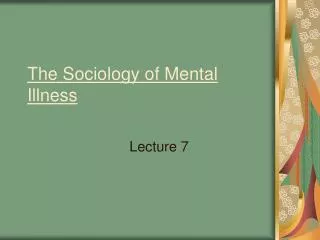
The Sociology of Mental Illness
The Sociology of Mental Illness. Lecture 7. Overview. problematic nature of the data question around what counts as a mental illness or disorder mental illness as social construction. Problems with measuring mental illness Sociological theories of mental disorder
1.78k views • 23 slides

Sociology of Health and Illness. Week 1. Conceptualising and Defining Health and Illness. Overview of Lecture. conceptual foundations of course. problems associated with conceptualising and defining health and illness;
1.52k views • 18 slides

HEALTH AND ILLNESS
HEALTH AND ILLNESS. Assoc. Prof. Petko Salchev, MD, PhD. HEALTH AND ILLNESS.
1.22k views • 29 slides
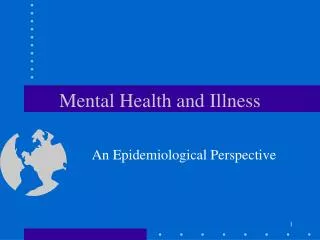
Mental Health and Illness
Mental Health and Illness. An Epidemiological Perspective. Mental Health-Everybody’s Business. Peter Sims Professor of Public Health medicine University of Papua New Guinea <[email protected]>. Teaching and Learning Aims.
524 views • 23 slides
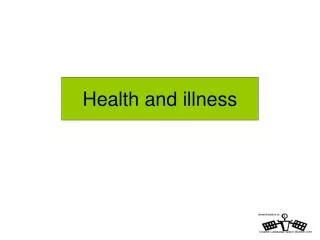
Health and illness
Health and illness. Health and Illness – Collocations Match the two columns. . e. 1. g. 2. b. 3. f. 4. d. 5. Can you think of any more health problems?. a. 6. 7. c. 8. h. Pre-listening activity . When the last time you were sick? What happened?
966 views • 6 slides

Health and Illness
Health and Illness. Chapter 4. Definitions. Health: defined by each person WHO: “Health is a state of complete physical, mental, and social well being, not merely the absence of disease or infirmity”. Disease: pathological change in structure &/or function
5.28k views • 9 slides

Mental Health and Illness. Overview of Approaches, Definitions, Perspectives. Continuous or discrete?. Continuous model: Mental Health Mental Illness +++++++++++++++++++++++++++++ Healthy>>>>Adjustment reaction>>>>Neurosis>>>>Psychosis
1.23k views • 33 slides
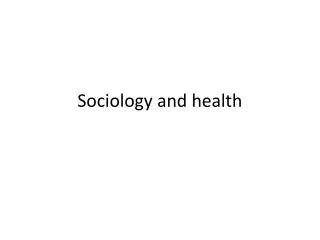
Sociology and health
Sociology and health. Session aims. To explore sociology as a discipline To identify how sociology contributes to understandings of health and illness To identify how society affects health . What is sociology? . The study of interactions between groups and individuals
853 views • 20 slides
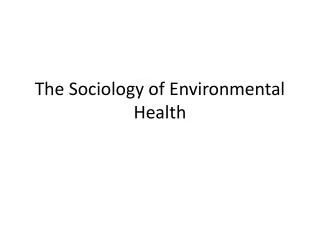
The Sociology of Environmental Health
The Sociology of Environmental Health. Sociological Processes & Environmental Health Assessments . A number of sociological processes play a role in environmental health assessments Gender inequality (EBCM) Racial and ethnic identity Social norms and structures (GWI) Political economy
491 views • 13 slides

HEALTH, ILLNESS AND SOCIETY
HEALTH, ILLNESS AND SOCIETY. By Dr. Frank Elwell. ACUTE DISEASES. DISEASES WITH FAIRLY QUICK, AND SOMETIMES DRAMATIC AND INCAPACITATING ONSET AND FROM WHICH A PERSON EITHER DIES OR RECOVERS. CHRONIC DISEASES. PROGRESS OVER A LONG PERIOD OF TIME AND OFTEN EXIST LONG BEFORE THEY ARE DETECTED.
940 views • 80 slides

SOCIOLOGY AND HEALTH
SOCIOLOGY AND HEALTH. Sociological Perspectives – A set of ideas that claims to explain how Society or parts of society work. RESEARCH TWO THEORIES REVIEW THE EVIDENCE FOR THE THEORIES and RELATE THEORIES TO A SPECIFIC HEALTH ISSUE.
525 views • 14 slides

The Sociology of Environmental Health. DEP vs EP. Dominant Epidemiological Paradigm Biomedical model Individual Genetic Medical/etiology Neutrality of medicine Treatment Risk management . Environmental Paradigm Population Environmental and political factors Prevention
252 views • 8 slides
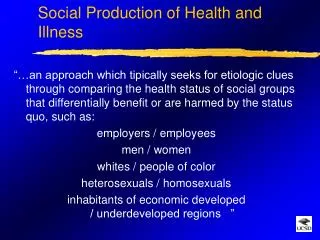
Social Production of Health and Illness
Social Production of Health and Illness. “…an approach which tipically seeks for etiologic clues through comparing the health status of social groups that differentially benefit or are harmed by the status quo, such as: employers / employees men / women whites / people of color
220 views • 10 slides
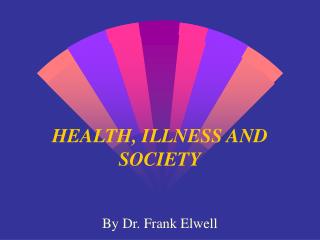
HEALTH, ILLNESS AND SOCIETY. By Dr. Frank Elwell. ACUTE DISEASES. DISEASES WITH FAIRLY QUICK AND SOMETIMES INCAPACITATING ONSET. PEOPLE EITHER DIE OR RECOVER FROM ACUTE DISEASES. CHRONIC DISEASES. PROGRESS OVER A LONG PERIOD OF TIME AND OFTEN EXIST LONG BEFORE THEY ARE DETECTED.
906 views • 76 slides
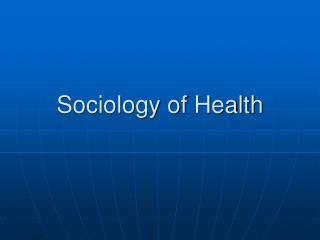
Sociology of Health
Sociology of Health. Hypothalamus. Lateral increases hunger Insulin sensitive Ventromedial: glucose sensitive: decreases hunger: Orexin secreted increasing hunger Gherlin: produced by stomach when empty increases hunger, switches when full. PPY: intestines are full, decreases hunger
690 views • 43 slides

HEALTH AND ILLNESS. Introduction.
254 views • 9 slides
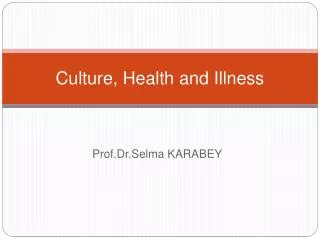
Culture , Health and Illness
Culture , Health and Illness. Prof.Dr .Selma KARABEY.
654 views • 45 slides
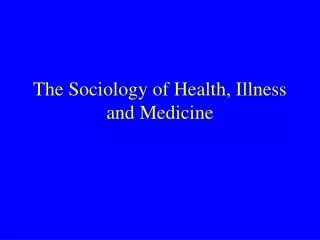
The Sociology of Health, Illness and Medicine
The Sociology of Health, Illness and Medicine. Topics in Medical Sociology:. Epidemiology Public health efforts and other policy issues Formal organizational aspects of healthcare Social and cultural influences on health and illness The socialization of caregivers
324 views • 12 slides
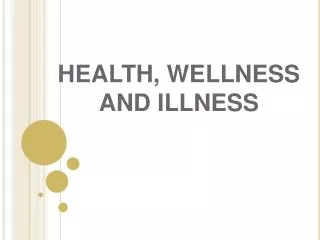
HEALTH, WELLNESS AND ILLNESS
HEALTH, WELLNESS AND ILLNESS. What Is Health?. What Is Health?. Definition of Health?. WHO, 1947. “Health is state of complete physical, mental and social well-being and not merely the absence of disease and infirmity”. Dunn, 1967.
1.18k views • 32 slides

880 views • 80 slides

The Sociology of Chronic Illness & Disability
The Sociology of Chronic Illness & Disability. Jonathan Gabe Royal Holloway, University of London. Introduction. Chronic Illness covers wide range of conditions epilepsy – arthritis – heart disease - asthma Has temporal dimension – chronic = khronos (Greek for time) – long lasting
503 views • 39 slides

IMAGES
VIDEO
COMMENTS
health and illness ,an overview. 1. 2. Health : health is an ideal state of physical and mental well being ,something to strive for but never to attain . Good health is a prerequisite of human productive and developmental process. 3. Illness : An illness is the response ,the person has to disease . It is an abnormal process in which the persons ...
An Image/Link below is provided (as is) to download presentation Download Policy: ... WHO (1947). Theoretical way of understanding a concept or idea. Models of Health and Illness. Models. 433 views • 19 slides. Health and Wellness. Health and Wellness. Health Indicators Clear, bright eyes Smooth, glossy coat Good appetite Energy Interest in ...
Wellness = an overall state of well-being, total health. Dimensions of wellness. Physical wellness. Avoiding bad habits, making good decisions. Emotional wellness. Trust, self-esteem, self-control. Intellectual wellness. Openness to new ideas, thinking critically, creativity. Spiritual wellness.
Presentation Transcript. Health and Illness Chapter 4. Definitions • Health: defined by each person • WHO: "Health is a state of complete physical, mental, and social well being, not merely the absence of disease or infirmity". • Disease: pathological change in structure &/or function • Illness: response of person to disease.
Download the Healthy Relationships and Communication Skills - 11th Grade presentation for PowerPoint or Google Slides. High school students are approaching adulthood, and therefore, this template's design reflects the mature nature of their education. Customize the well-defined sections, integrate multimedia and interactive elements and allow ...
Illness is a progression from the mere presence of a medical problem or condition to the presentation of disabling symptoms and signs. The underlying meaning is that it is possible to have a disease without being ill and vice versa—invariably it is possible to have a disease without any awareness of it.
Main idea of health- illness continuum model Health and illness are seen as relative concepts and not as separate absolutes. Health and illness as a graduated scale has two ends. Health is a dynamic state that fluctuates as a person adapts to changes in the internal and external environments to maintain a state of well- being.
Presentation Transcript. HEALTH AND ILLNESS Our concepts for health and illness, life and death evolve through the ages, beginning with the secret of birth and death, our place in the surrounding world, life and health as individual values and health care as a social value, legal right and aim. Empirical-sensory knowledge • It is typical of ...
This chapter provides an overview of the problem of conceptual definition of 'health' and 'disease' as a background to situate and introduce the discussion about health outcomes and value of new medical interventions. This work reflects and discusses broader literature on this topic by highlighting the available - and lacking - definitions in the specific context of health ...
Introduction. Analysing the concept of illness is a rather complex task. Just like for the concept of health - presented by the philosopher Hans - Georg Gadamer as a "[…] general feeling of personal well-being [which] appears mostly when we, in our feeling of personal well-being, are open to new things, are ready to start new business, without considering demands made on us" [] - there ...
Chapter 3Health, Illness, and Disparities. Definitions of Health States • Health—a state of complete physical, mental, and social well-being, not merely the absence of disease or infirmity • Illness—the unique response of a person to a disease; an abnormal process involving changed level of functioning • Wellness—an active state of ...
Health Presentation Templates. Venngage provides an extensive selection of health presentation templates, tailored to meet the specific needs of healthcare professionals, medical institutions, and wellness advocates. These templates offer a powerful and visually appealing platform to communicate critical health information, research findings ...
This article aims to define and explain health, expose the concept of health and bring to light dimensions of health as well as its social construct. The word health is derived from whole, hale and healing, signaling that health concerns the whole person and his or her integrity, soundness or well being. (Naidoo and Wills, 1994) Download Free PDF.
health and illness,health care team and agencies. 1. 2. Health : • Health means different things to different people, depending in the situation. • Level of functional metabolic efficiency of a living organism • Good health is a prerequisite of human productive and developmental process. 5.
5 Models of Health and Illness. The agent-host-environment model: The agent, host, and environment interact in ways that create risk factors. The health-illness continuum: Views health as a constantly changing state with high-level wellness and death on opposite sides of a continuum The high-level wellness model The health belief model The ...
This PowerPoint lesson is for teaching English lessons about sickness and health. The presentation includes slides to practice sickness vocabulary in English and slides to practice asking and answering ' What's the matter? ' - ' I've got a (fever) .'. Key vocabulary includes headache, toothache, cold, fever, cough, stomachache ...
Vivian Free Spring Template for Google Slides or PowerPoint presentations. Rochester Free Elegant Template for Google Slides or pptx. Make your presentations and lessons stand out with these free templates for Health and Wellness. Download them to use with PowerPoint or edit them in Google Slides and start creating!
ppt about illnesses. 222 uses. kiscsepo. Health and illnesses. This ppt intends to . 4477 uses. mantica. Illness and Deseases. This PPP could help . 1630 uses. Uaialurra. TALKING ABOUT ILLNES. Power point with a l. 1586 uses. capricorniana. HEALTH AND ILLNESS. HEALTH AND ILLNESS P. 1398 uses. dnommey. Illnesses and Pain. This is a short Powe ...
Health and illness. An Image/Link below is provided (as is) to download presentation Download Policy: Content on the Website is provided to you AS IS for your information and personal use and may not be sold / licensed / shared on other websites without getting consent from its author. Download presentation by click this link.
Free Google Slides theme and PowerPoint template. Teaching kids what to do to prevent illnesses has always been an important thing, but due to the COVID-19 pandemic, now it's even more crucial than ever. To make your lesson more interesting for your students, you can try using this editable template and create a slideshow with it.
NS crown. This is PDF of 1st unit (intro to health & illness) of Fundamental Of Nursing book of 1st year of Bsc nursing/GNM/ANM . It's very easy to read and understand the fundamentals of nursing . Read more. Education. 1 of 106. Download Now. Download to read offline.
Animal Health Livestock and Poultry Disease; Avian Disease; Avian Influenza; ... Centers for Disease Control and Prevention, and State veterinary and public health officials are investigating an illness among dairy cows. As we learn more about this evolving situation, APHIS will continue to provide confirmatory testing for samples from ...
Health and Illness. Health and Illness. Chapter 4. Definitions. Health: defined by each person WHO: "Health is a state of complete physical, mental, and social well being, not merely the absence of disease or infirmity". Disease: pathological change in structure &/or function. 5.28k views • 9 slides
Society has become more unequal and the poor sicker. Summary • There are two broad approaches in sociology • Sociology examines the social dimensions of health and illness • It is particularly concerned with inequality in health and illness • It considers how social structures influence our chances of becoming ill and receiving health care.